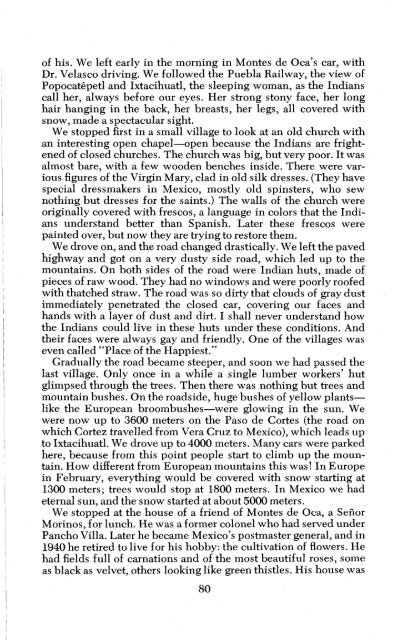My Years with Ludwig von Mises.pdf - The Ludwig von Mises Institute
My Years with Ludwig von Mises.pdf - The Ludwig von Mises Institute
My Years with Ludwig von Mises.pdf - The Ludwig von Mises Institute
Create successful ePaper yourself
Turn your PDF publications into a flip-book with our unique Google optimized e-Paper software.
of his. We left early in the morning in Montes de Oca~s car, <strong>with</strong><br />
Dr. Velasco driving. We followed the Puebla Railway, the view of<br />
Popocatepetl and Ixtacihuatl, the sleeping woman, as the Indians<br />
call her, always before our eyes. Her strong stony face, her long<br />
hair hanging in the back, her breasts, her legs, all covered <strong>with</strong><br />
snow, made a spectacular sight.<br />
We stopped first in a small village to look at an old church <strong>with</strong><br />
an interesting open chapel-open because the Indians are frightened<br />
of closed churches. <strong>The</strong> church was big, but very poor. It was<br />
almost bare, <strong>with</strong> a few wooden benches inside. <strong>The</strong>re were various<br />
figures of the Virgin Mary, clad in old silk dresses. (<strong>The</strong>y have<br />
special dressmakers in Mexico, mostly old spinsters, who sew<br />
nothing but dresses for the saints.) <strong>The</strong> walls of the church were<br />
originally covered <strong>with</strong> frescos, a language in colors that the Indians<br />
understand better than Spanish. Later these frescos were<br />
painted over, but now they are trying to restore them.<br />
We drove on, and the road changed drastically. We left the paved<br />
highway and got on a very dusty side road, which led up to the<br />
mountains. On both sides of the road were Indian huts, made of<br />
pieces of raw wood. <strong>The</strong>y had no windows and were poorly roofed<br />
<strong>with</strong> thatched straw. <strong>The</strong> road was so dirty that clouds of gray dust<br />
immediately penetrated the closed car, covering our faces and<br />
hands <strong>with</strong> a layer of dust and dirt. I shall never understand how<br />
the Indians could live in these huts under these conditions. And<br />
their faces were always gay and friendly. One of the villages was<br />
even called "Place of the Happiest."<br />
Gradually the road became steeper, and soon we had passed the<br />
last village. Only once in a while a single lumber workers~ hut<br />
glimpsed through the trees. <strong>The</strong>n there was nothing but trees and<br />
mountain bushes. On the roadside, huge bushes of yellow plantslike<br />
the European broombushes-were glowing in the sun. We<br />
were now up to 3600 meters on the Paso de Cortes (the road on<br />
which Cortez travelled from Vera Cruz to Mexico), which leads up<br />
to Ixtacihuatl. We drove up to 4000 meters. Many cars were parked<br />
here, because from this point people start to climb up the mountain.<br />
How different from European mountains this wast In Europe<br />
in February, everything would be covered <strong>with</strong> snow starting at<br />
1300 meters; trees would s'top at 1800 meters. In Mexico we had<br />
eternal sun, and the snow started at about 5000 meters.<br />
We stopped at the house of a friend of Montes de Dca, a Sefior<br />
Morinos, for lunch. He was a former colonel who had served under<br />
Pancho Villa. Later he became Mexico~spostmaster general, and in<br />
1940 he retired to live for his hobby: the cultivation of flowers. He<br />
had fields full of carnations and of the most beautiful roses, some<br />
as black as velvet, others looking like green thistles. His house was<br />
80

















